Mateer Crew – Assigned 753rd Squadron – February 22, 1945
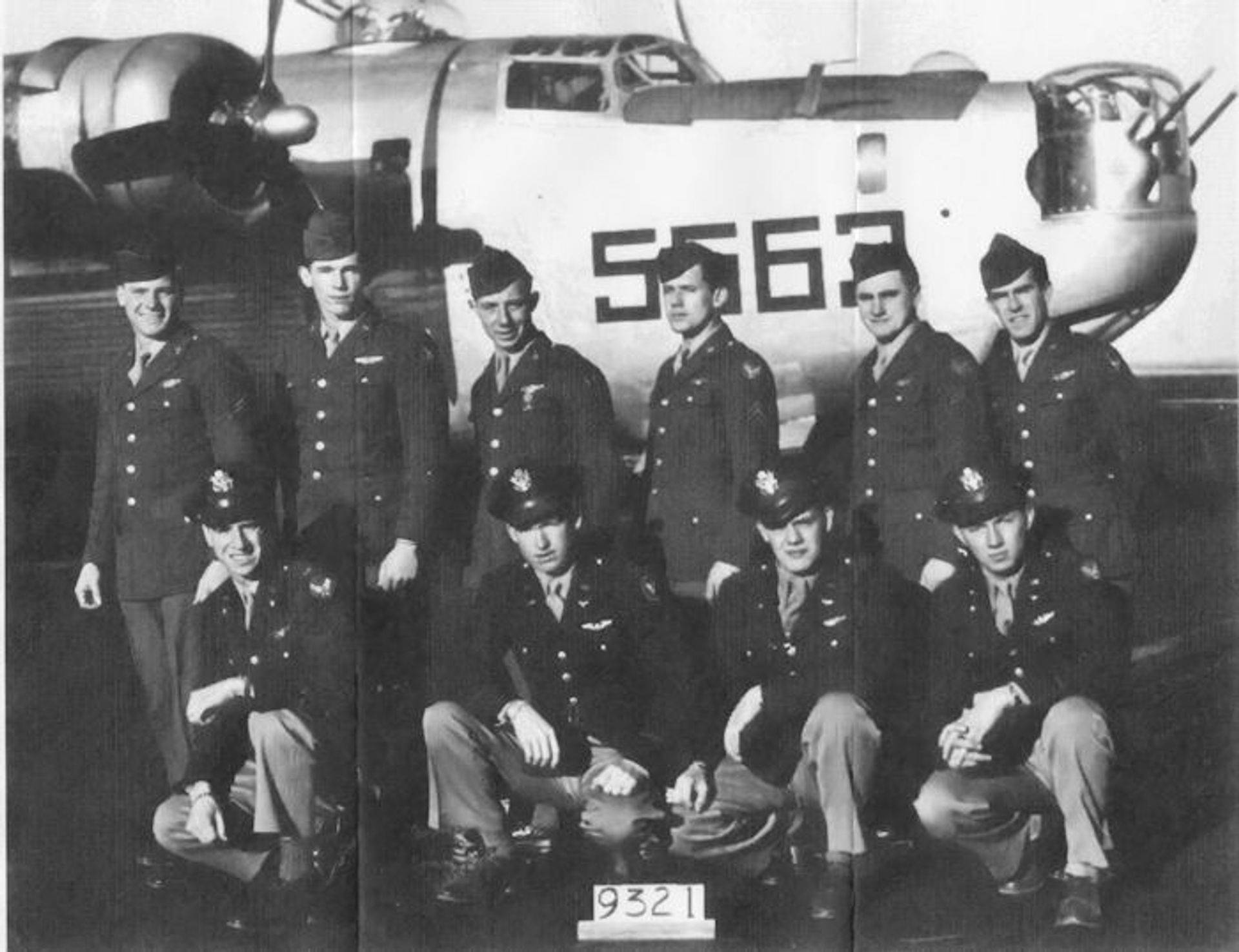
Standing: (far left) Charles Essenson – G, (far right) Danny Desjardin – G
Kneeling: Arnold Koenig – N, Charles Mateer – P, Ralph Peters – CP, Sheridan Ostrander – B
If you can identify any crew members, please contact me.
(Photo: Sally Peters)
Flying at the End of Hostilities
| Rank | Name | Serial # | Pos | Date | Status | Comments |
|---|---|---|---|---|---|---|
| 1Lt | Charles Q Mateer | 02060957 | Pilot | 25-Apr-45 | FEH | Load List - Bad Reichenhall |
| 2Lt | Ralph E Peters | 02062280 | Co-pilot | 25-Apr-45 | FEH | Load List - Bad Reichenhall |
| F/O | Arnold R Koenig | T135774 | Navigator | 25-Apr-45 | FEH | Load List - Bad Reichenhall |
| S/Sgt | Joseph O Juranowitch | 33697148 | Radio Operator | 25-Apr-45 | FEH | Load List - Bad Reichenhall |
| S/Sgt | Helmut F Kottke | 12148253 | Flight Engineer | 25-Apr-45 | FEH | Load List - Bad Reichenhall |
| S/Sgt | Donald L Albert | 15128140 | Aerial Gunner | 25-Apr-45 | FEH | Load List - Bad Reichenhall |
| S/Sgt | Daniel J Desjardin | 31117285 | Aerial Gunner | 25-Apr-45 | FEH | Load List - Bad Reichenhall |
| S/Sgt | Charles P Essenson, Jr | 12220950 | Armorer-Gunner | 25-Apr-45 | FEH | Load List - Bad Reichenhall |
| Sgt | William R Morrison | 15313948 | Aerial Gunner | 25-Apr-45 | FEH | Load List - Bad Reichenhall |
2Lt Charles Mateer and crew arrived as a replacement crew at Horsham in late February 1945. Lt Sheridan Ostrander, the crew’s bombardier, was not assigned with the crew. Early in the war in 1942-43, he had been with the 13th Air Force, 307BG 372BS as a bomb site mechanic before undergoing bombardier training in 1944 and being commissioned as a Second Lieutenant. At this stage of the airwar in the ETO, newly trained bombardiers were being retrained as navigators. It is unknown where Ostrander was assigned.
The crew flew their first mission about two weeks later. In all they completed seven missions in March and six in April. On April 25th they participated on the raid to bomb the marshalling yards located at Bad Reichenhall. This would be the Group’s 240th and last combat mission in the war. The load list for this date shows that S/Sgt William A. Howell (assigned in December 1944 as a gunner on the crew of Lt Ellis Lanquist) flew as RCM (Radar Counter Measures) Operator with the crew.
Those crews who had not completed a combat tour by war’s end, were slated to return the Group’s Liberators to the States. There were over 60 Ferry Crews, consisting of a combat crew and 10-15 ground men. These aircraft, crews and passengers departed Horsham in June 1945.
Missions
| Date | Target | 458th Msn | Pilot Msn | Serial | RCL | Sqdn | A/C Msn | A/C Name | Comments |
|---|---|---|---|---|---|---|---|---|---|
| 12-Mar-45 | FRIEDBURG | 202 | 1 | 42-51196 | Q | J3 | 45 | THE GYPSY QUEEN | |
| 15-Mar-45 | ZOSSEN | 204 | 2 | 42-95108 | B | Z5 | 66 | ENVY OF 'EM ALL II | |
| 19-Mar-45 | LEIPHEIM | 207 | 3 | 42-95120 | M | Z5 | 82 | HOOKEM COW / BETTY | |
| 21-Mar-45 | HESEPE | 209 | 4 | 42-50640 | O | Z5 | 35 | BUGS BUNNY | |
| 23-Mar-45 | OSNABRUCK | 211 | 5 | 42-50516 | V | J3 | 29 | STARDUST | |
| 24-Mar-45 | KIRKOFF | 213 | 6 | 42-50516 | V | J3 | 30 | STARDUST | |
| 30-Mar-45 | WILHELMSHAVEN | 215 | 7 | 42-51196 | Q | J3 | 52 | THE GYPSY QUEEN | |
| 02-Apr-45 | TIRSTROP | ABN | -- | 42-51196 | Q | J3 | -- | THE GYPSY QUEEN | ABANDONED |
| 06-Apr-45 | HALLE | 219 | 8 | 42-51196 | Q | J3 | 55 | THE GYPSY QUEEN | |
| 07-Apr-45 | KRUMMEL | 220 | 9 | 42-50516 | V | J3 | 32 | STARDUST | FLYING w/466TH "C" GRP |
| 14-Apr-45 | POINTE DE GRAVE | 225 | 10 | 42-51196 | Q | J3 | 61 | THE GYPSY QUEEN | |
| 16-Apr-45 | LANDSHUT | 227 | 11 | 42-100366 | H | Z5 | 78 | MIZPAH | |
| 18-Apr-45 | PASSAU | 228 | 12 | 42-51196 | Q | J3 | 63 | THE GYPSY QUEEN | |
| 25-Apr-45 | BAD REICHENHALL | 230 | 13 | 42-51196 | Q | J3 | 65 | THE GYPSY QUEEN |
B-24H-30-DT 42-51196 J3 Q The Gypsy Queen
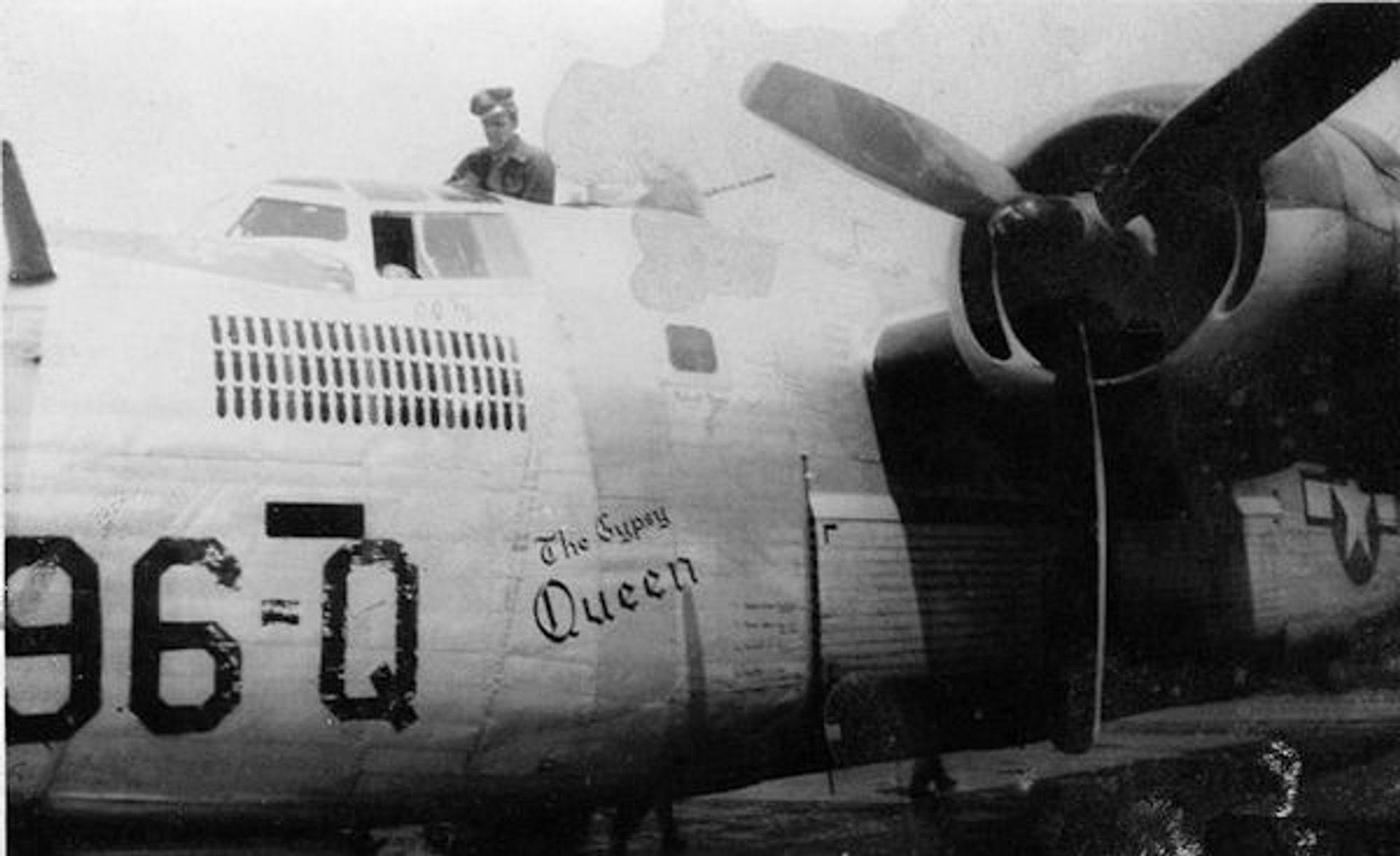
Mateer and crew flew this aircraft on 6 of their 13 missions and were assigned to ferry it back to the States in June 1945
Co-pilot Ralph Peters is in the escape hatch
(Photo: Kenneth Hosker)
Life of an Airman During WW II
by Lucas Weber
Although many people joined the military thinking of adventure or something fun to do, serving in the armed forces demonstrated rights and responsibilities because it is a great responsibility to serve in the armed forces as an airman, to protect the rights of American citizens, and the responsibility to protect the sovereignty of other countries.
With Germany wanting to take control of the world and leave only the “superior race”, it was a life changing time for the whole world. Adolf Hitler, Chancellor of Germany, started to attack neighboring countries around Germany. Soon Germany made signed an alliance with both Italy and Japan. After Japan took over southern Indochina the U.S., Britain, and the Netherlands stopped supplying natural resources to Japan. Therefore Japan needed to get natural resources a different way. They needed to take control of countries including Burma, Malaya, The East Indies, and the Philippines. The Japanese military’s largest concern was the U.S. Pacific Fleet which was stationed in Pearl Harbor. To eliminate this concern, the Japanese navy launched a surprise attack on Pearl Harbor. This caused America to declare war on both Japan and Germany.[1]
While this was going on in the pacific, Britain had already declared war against Germany. The attack on Pearl Harbor brought America into the war fighting with Britain against Nazi Germany. Much of the fighting between Britain and Germany was being fought in the air. This was the first time a new branch or the armed service was a main role in World War II. This branch was called the Army Air Corps.
The Army Air Corps, which was established July 2, 1926, fought to be a separate branch of military. Until World War II, the Army Air Corps wasn’t seen as a separate branch of military. Aviator’s jobs were only to support troops on the ground and aviators reported to the ground force commanders. The Army Air Corps wanted to become a main player in the military but with lack of funding due to the great depression this wasn’t possible to accomplish but the U.S. military needed to gain air superiority to become a strategic force. The Army Air Corps was part of the army until 1947 when it became a separate branch which is still known today as the U.S. Air Force.[2]
In the Army Air Corps every member was a volunteer. Nobody was drafted to be an airman. Some were influenced by Charles Lindbergh’s popularity. Some chose to enlist in the Air Corps to stay away from the ground combat. Many others chose to join the military as a way to fulfill their responsibility to their country and to protect their family, community, and most importantly their rights as an American citizen.

My grandfather, Ralph E. Peters, was one of the many men that enlisted into the U.S. Army Air Corps. Born October 6th, 1924, he was the younger of two sons born to middle class parents and raised in Cincinnati, Ohio. His childhood hobbies were swimming and aviation. He attended catholic grade school and high school then started college attending for six months before enlisting on November 23, 1942. He was called to active duty on February 25, 1943, arriving at Kessler Field in Biloxi, Mississippi on February 27th for basic training. “Only my Father, by my request was present at my departure”. The only things in hand were toiletries and a tote bag.[3]
After reporting to basic training, leave of absences were granted to airmen under extreme circumstances only. My grandfather was notified June 25th, four months after reporting for active duty, that his brother had passed away. He was granted an eight day leave of absence to return to the states to attend his brother’s funeral.
Upon his return following his leave he was sent to San Antonio, Texas AAFCC[4] to begin classification selection.[5] Classification selection is a stage where an airman is tested through different selection processes. The first phase tested general knowledge including their ability to read maps and their understanding of the principles of mechanics. The second phase tested motor coordination and physical dexterity and the final phase was a private interview with a psychologist. Before and after these phases a physical examination was given. “”The physical exam is the most critical event in a military pilot’s career”. Some of the flight instructors bragged that they could teach almost anyone to fly, but… “The number that could pass the flight physical is a far smaller group””.[6] Classification determined whether the airman would train as a navigator, bombardier, or pilot. The training and selection process for these positions were very rigorous such that by 1944 one of every six crew members of a B-17 or B-24 aircraft were washouts from the cadet program but even before that more than 50% had failed the physical and written tests.[7]
On October 1st, 1943 my grandfather became a cadet with a pilot classification. His pre-flight training then began which included weapons training in San Antonio SAACC (P).[8] He was trained in various weapons including a Thompson Sub-Machine gun. He was qualified as a marksman by the end of November.[9]
Primary flight training began with relocation to Mustang Field, El Reno, Oklahoma AAFFTD[10]. There Cadet Peters trained in a primary trainer-PT19. It had two open cockpits with the student in the front and the instructor in the rear. There were no canopies so the instructor and the trainee wore helmets and goggles[11]. Cadet Peters flew nearly every day during his primary flight training starting with short instructor led flights progressing to solo flights of nearly two hours in duration.
The next level in training took Peters to Garden City Army Airfield, Kansas for basic training where he flew a Vultee BT-13. This plane had a radial engine, a stick instead of a wheel and was very powerful. It was a different level of flying that required considerably more skill.[12] He flew almost every day for two months on this trainer.[13]
During basic training the trainees were given flying regulations such as; you are on the controls at all times unless an instructor says, no flying within 600’ of another plane or within 300’ of clouds. Also in the instruction manual, it stated “There is no regulation saying you cannot put an elephant in the back seat, but you know that it would not be tolerated…. if you think it might be wrong DON’T DO IT”.[14]
Basic training also taught more specific techniques on handling aircraft such as taxing, take-off, climbs, turns, stalls, acrobatics, spins and landings. Basic training was a program that followed strict military orders. Airmen were expected to be attentive, respectful, courteous, and be willing to learn. Instructors were not forgiving but the cadets looked up to their instructors with highest regards throughout their military service. To this point, encompassing primary and basic training, Cadet Peters had recorded almost 140 hours of flight time in training.[15]
Advanced training took airmen a step further in both aircraft flown and skills required to fly them. The airmen were healthier than other service men to begin with and more so at the end of training. They volunteered for combat. They regarded themselves – and were so regarded by others – as the cream of the crop.[16] Cadet Peters reported to FAAF[17] for his advanced training on April 17th, 1944. The aircraft he trained in was a Cessna UC-78. The Cessna UC-78 was an all wooden aircraft consisting of two engines used to train many cadets before moving to train on B-17 and B-24 bombers. Here the emphasis was training on multi-engine and larger aircraft. The AAF in WWII trained the world’s largest force. On average, before going into combat, the men had 360 hours of flying time compared to the German pilots with an average of 110 hours. This airtime showed graphically positive results on air combat during the height of the war in 1944 and 1945.[18]
“The first lesson is that you can’t lose a war if you have command of the air, and you can’t win a war if you haven’t” – General James Doolittle, Commander of the 8th Air Force.[19] On June 26th, 1944 Cadet Peters received an honorable discharge from training and graduated as a pilot in the AAF. The next day he was promoted to the rank of lieutenant (See Appendix A – Lieutenant Peters photo and Appendix O – Honorable Discharge Certificate from training). Graduation was followed by a two week leave before reporting to Kessler Field Biloxi, Mississippi for co-pilot training which was solely in a B-24 Aircraft totaling approximately 40 hours of flight time before receiving his crew assignment.[20]
Flight crews consisted of men from a cross section of the United States. No matter what type of men they were, the lesson they learned was “you take care of your buddy because they were going to take care of you”. The camaraderie the crew formed lasted a lifetime. Lieutenant Peters sat in the co-pilot seat on the B-24 Liberator. One of the many places men were positioned in the B-24. There were a total of 10 positions that any one man would occupy during a flight. The pilot, 1st Lieutenant Mateer sat alongside Lieutenant Peters. The pilot, co-pilot, navigator and bombardier were officer positions. The other positions consisted of the radio operator, nose gunner, engineer, top turret gunner, waist gunner, and the tail gunner. These positions were occupied by enlisted airmen.“The B-24 was a man’s airplane. It could be sternly unforgiving. It required, and sometimes demanded, almost superhuman strength to fly. On a long mission it could wear out even the strongest pilot”.[21] The B-24 is a long range bomber with a crew size of 10 men. It was an important part of the air war because it was made in far greater numbers and saw action in every allied front and with numerous air forces.
Every airman associated with a B-24 was assigned to a bomb group which branched into a bomb squadron and then the airman’s individual crew. Lieutenant Peters’ crew 9321 (See Appendix B, C & D – Crew 9321 photo, order to assemble and individual crew assignment within aircraft) was assigned to the 753rd Bomb Squadron, part of the 458th Bomb Group in February 1945 following their arrival the day before in the ETO. Their transportation time to the ETO took three weeks. A week after arrival they were transferred to the 754th Bomb Squadron.[22]
The previous March 1944 the 458th Bomb Group had joined the 96th Combat Wing of the 8th Air Force in the ETO.[23] There were six planes in a bomb squadron and a total of six bomb squadrons in a bomb group adding up to thirty-six B-24’s in a bomb group.[24] The 458th Bomb Group was located at the airbase in Horsham Saint Faith, Europe. The air attack from B-24’s came from many airbase locations including England, Italy, and the Pacific. In England thirteen airbases, including the 458th Bomb Group’s, were located in or near Norwich. The 458th’s was located at Horsham Saint Faith in Norwich. (See Appendix E – Horsham Saint Faith Air Base)
At Horsham Saint Faith the military living quarters were one of the best in England. The base was built in 1939 by the RAF[25] and was opened on June 1, 1940 as a bomber station. The officers stayed in permanent brick housing instead of tents and Quonset huts as were at many of the other air bases (See Appendix F – officer’s quarter and enlisted housing). Each house was shared with 16 officers from various crews. Each airman had their own wash bowl and shared a bathroom with several other officers. The airmen were “well taken care of”. Since the buildings were heated with coal, the buildings were sometimes cold since the coal usually ran out but the airmen kept warm with clothing. The food at Horsham was in some airmen’s opinion, better than food in the states. When they weren’t flying, some liked to drink and party while others would walk to Horsham from the base and visit pubs, attend dances and gatherings. The base also had clubs that had reading materials, games, and more.[26]
Lieutenant Peters flew in at least 13 missions during his time in the ETO. (See Appendix G and H – listing of missions with a general synopsis of the directive of the mission as well as a map of the mission locations.) Although the Gypsy Queen was the plane that Mateer’s crew 9321 considered their own, the crews flew in whichever plane was prepped to fly for the assigned mission. (See Appendix I – photos of the planes Peters flew) When flying a mission, the pilot and co-pilot were focused on flying the navigator’s route and completing the mission. They were sheltered from the gunner attacks and the bomb drops by the bombardier. They didn’t have time to worry about what the crew was doing. They had to be sure the plane kept flying and stayed in formation.[27] The possibility of capture was high for crew who needed to bail out of the aircraft. To help prevent capture each crew member was supplied with an escape kit with candy bars, a shot of morphine, a silk map of Europe (See Appendix J – silk map Peters held in his possession during flights) and a compass. These items were not much if they had been needed. The mean number of missions flown by any crew of the 8th Air force was 14.7. More than half the crews never got much past the half-way point in compiling the 25 missions required to go home.[28]
In May of 1945 Germany surrendered to the Allied forces. Lieutenant Peters and his crew ferried their B-24 back to the U.S. on June 16th, 1945 (See Appendix K and L – official discharge order and crew photo with the Gypsy Queen before ferrying it home). It took them 11 days to make this journey.[29] In August 15th, 1945 Japan surrendered to the allied forces and the AAF no longer needed a large supply of pilots so Lieutenant Peters was relieved of active duty on October 4th, 1945 (See Appendix M & N – separation and discharge papers). As a result of his service he was awarded the Air Medal with an Oak Leaf Cluster for meritorious achievement by accomplishing multiple missions over Occupied Continental Europe. (See Appendix P – Air Metal photo and certificate)
My grandfather, 2nd Lt. Ralph E. Peters, died August 11, 2013 at the age of 88. He had served his country, like others of his generation, with pride, because it was his responsibility. He didn’t talk about the war much after returning home. Not to his family or his friends. Not even to my grandmother who he was married to for 56 years. He had a few reunions with his flight crew. The last was for their 50th reunion in 1995 (See Appendix Q– crew reunion photo). They reminisced about their interests and they bonded from their time together serving our country but they never relived their time overseas. His service to our country lasted a brief 3 years with only 4 months of that time overseas but that time affected his life forever. Mr. Peters earned a bachelor’s degree in aeronautical engineering and his
professional career followed as a university professor. His obituary included the most important and impressive things in his life; his family, his career and his service to our country. (See Appendix R)
1 “Pearl Harbor” History of Pearl Harbor
2 “Army Air Corps.” Centennial of Army Aviation. The United States Army
3 Ralph Peters, Service Record in World War II, 1943-1945
4 Army Air Force Classification Center
5 Ralph Peters, Service Record in World War II, 1943-1945
6 Ambrose, Stephen E., The Wild Blue, The men and boys who flew the B-24’s over Germany, New York, NY, Simon & Schuster, 2001, Page 53-54
7 Ambrose, 52 & 54
8 San Antonio Aviation Cadet Center (Pilot)
9 Ralph Peters, Service Record in World War II, 1943-1945
10 Army Air Force Flight Training Detachment
11 Ambrose, 57
12 Ambrose, 68
13 Pilot Log Book, Ralph E Peters, August 4th, 1943
14 Garden City Army Airfield, Basic Flying Instructions for Students, Garden City, Kansas
15 Pilot Log Book
16 Ambrose, 102
17 Frederick Army Airfield, Frederick, Oklahoma
18 Ambrose, 75
19 “National WWII Memorial”
20 Ralph Peters, Service Record in World War II, 1943-1945
21 Ambrose, 77
22 Darin Scorza, 12/31/13 Email
23 European Theater of Operations
24 Ambrose, 113
25 Royal Air Force
26 Darin Scorza, 12/31/13 Email
27 Ambrose, 227
28 Ambrose, 111
29 Ralph Peters, Service Record in World War II, 1943-1945
Annotated Bibliography
Secondary Sources
(All materials courtesy: Lucas Weber, grandson of Ralph E. Peters)
June 1945

Standing: Charles Mateer, Arnold Koenig, Ralph Peters
Sitting: (5th from left) Dan Desjardin, (3rd from right) Charles Essenson
If you can identify anyone in the photo, please contact me.
HEADQUARTERS 458TH BOMBARDMENT GROUP (H)
Office of the Group Operations Officer
AAF 123 APO 558
Operations Order Number 46
7June 1945
Under authority contained in Letter ETOUSA, Subject: “Movement Orders, Shipment 10060”, File No. AG 370.5, CPGC, Dated 27 may 1945, the following A/C and personnel assigned thereto will proceed via Valley A/D by best available air route to Bradley Field, Windsor Locks, Connecticut, thence to Camp Miles Standish, Boston, POE. Personnel will report to the AAF Base Unit Commander at Bradley Field. AAF personnel are being returned for the purpose of authorized TD for rest and recuperation and for further assignment. Personnel listed on this order are on Detached Service and are being accounted for on Morning Report of the Air Echelon of the Squadron to which they are assigned. TDN 212/50425 FSA 1942-45 60-136 P-431-02.
Shipment No. 10060-VZ T-M-S: B-24H A/C Serial No. 42-51196 Crew No. 9 of 18
| NAME | GRADE | ARM OR SERVICE | ASN | CREW SPEC | MOS | |
|---|---|---|---|---|---|---|
| Mateer, Charles Q | 1st Lt. | AC | 0-2060057 | Pilot | 1092 | Box 429, Custer, South Dakota |
| Peters, Ralph E | 2nd Lt. | AC | 0-2062280 | Co-Pilot | 1092 | 3731 Marmian, Lane, Cincinnati, Ohio |
| Koenig, Arnold R | 2nd Lt. | AC | 0-2015414 | Navigator | 1034 | 3041 N. 77th Court, Elmwood Park, Illinois |
| Maultsby, William A | Sgt | AC | 18197961 | Gunner | 748 | San Saba, Texas |
| Kottke, Helmut F | S/Sgt | AC | 12148253 | Engineer | 748 | 95 Garfield St., North Bellmore, Long Island, NY |
| Juranowitch, Joseph O | S/Sgt | AC | 33697148 | Radio Operator | 757 | 1835 Elbow St., Pittsburgh, Penn. |
| Essenson, Charles P | Sgt | AC | 12220950 | Gunner | 612 | 1102 Gates Ave., Brooklyn, New York |
| Albert, Donald L | Sgt | AC | 15128140 | Gunner | 611 | 4740 South Ave Ext. Youngstown, Ohio |
| Morrison, William R | Sgt | AC | 15313948 | Gunner | 611 | West Union, Ohio |
| Desjardin, Daniel J | Sgt | AC | 31117285 | Gunner | 612 | 37 Cottage St., Lewiston, Maine |
| Hosker, Kenneth | T/Sgt | AC | 11050417 | Crew Chief | 750 | 93 Robinson Street, Lynn, Mass. |
| Horn, Robert J | Sgt | AC | 36543081 | Airplane Eng Mech | 747 | Irish Hillis, Brooklyn, Michigan |
| Chambers, Clifford R | Sgt | AC | 39263880 | Teletype Mech | 239 | 1625 Monterey Road, South Pasadena, Calif. |
| Feldman, Harry | Pvt | AC | 32412004 | Radio Mech | 754 | 4716 14th Ave., Brooklyn NY |
| Moore, Lester H | Sgt | AC | 17020564 | Airplane Eng Mech | 747 | Route #8, Topeka, Kansas |
| Overstreet, Joseph R | S/Sgt | AC | 34127753 | Decon Equip Oper | 809 | Route #2, Box 3, Millen, Ga. |
| McCleary, Gerald W | Pfc | AC | 33940020 | Truck Driver, Light | 345 | R.D. #2, Clarion, Penn. |
| Alexander, Ralph G. | Sgt | AC | 14160574 | Airplane Elect Mech | 685 | Route #2, Franklin, Tenn. |
| Botti, George j | Sgt | AC | 32713501 | Airplane Elect Mech | 685 | 5 Chelsea Place, Great Neck, Long Island, NY |
| Long, Robert Jr. | Pfc | AC | 32113566 | Clerk | 055 | 315 S. First Ave, Mount Vernon, NY |
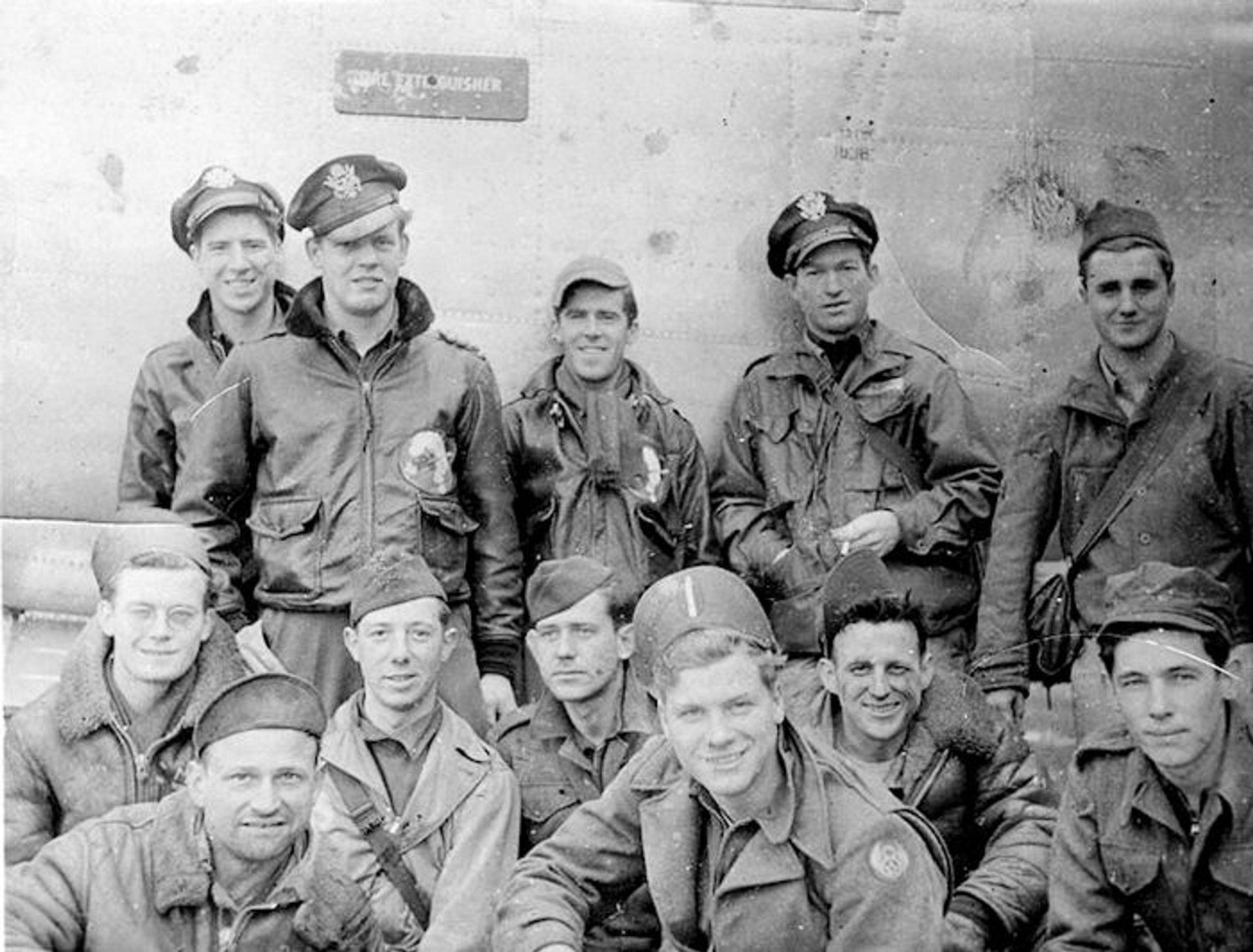
Middle row: (2nd from left) Kenneth Hosker
Front: (with 8AF patch) Charles Essenson
If you can identify anyone, please contact me.
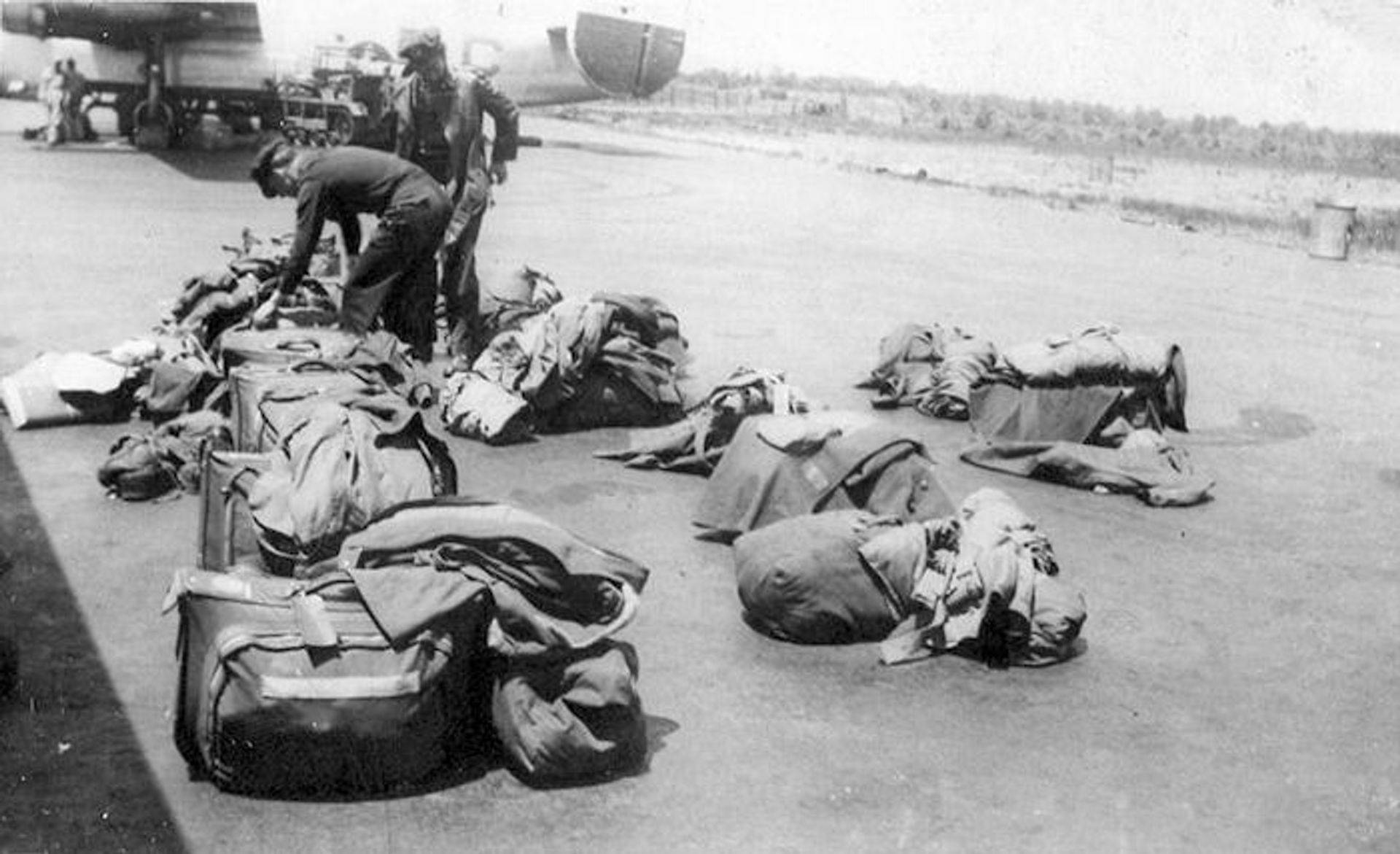
(Photos Kenneth Hosker)
1995 – Dayton, Ohio
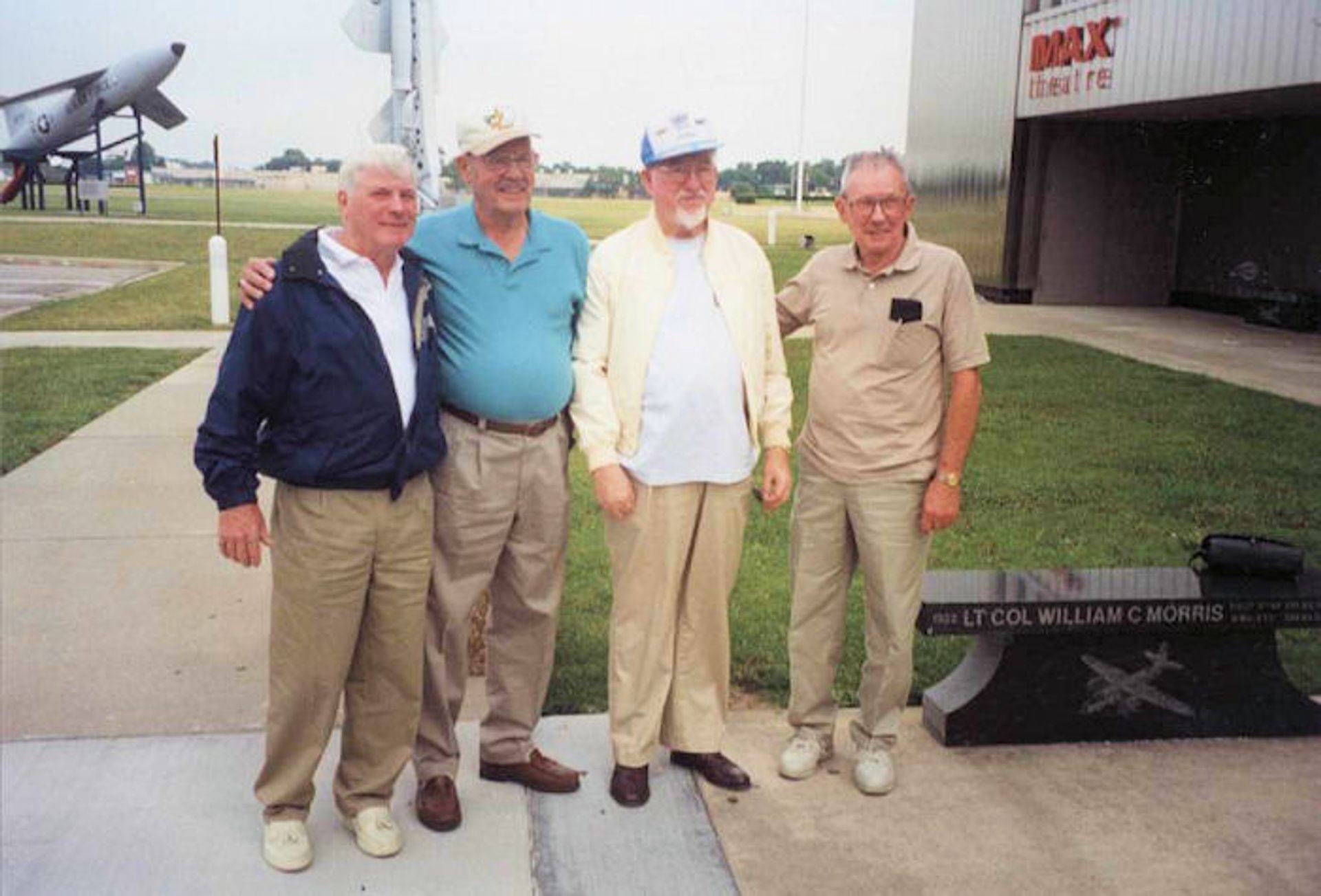
Members of the crew at their 50th reunion
Charles Essenson, Ralph Peters, Charles Mateer, William Morrison

